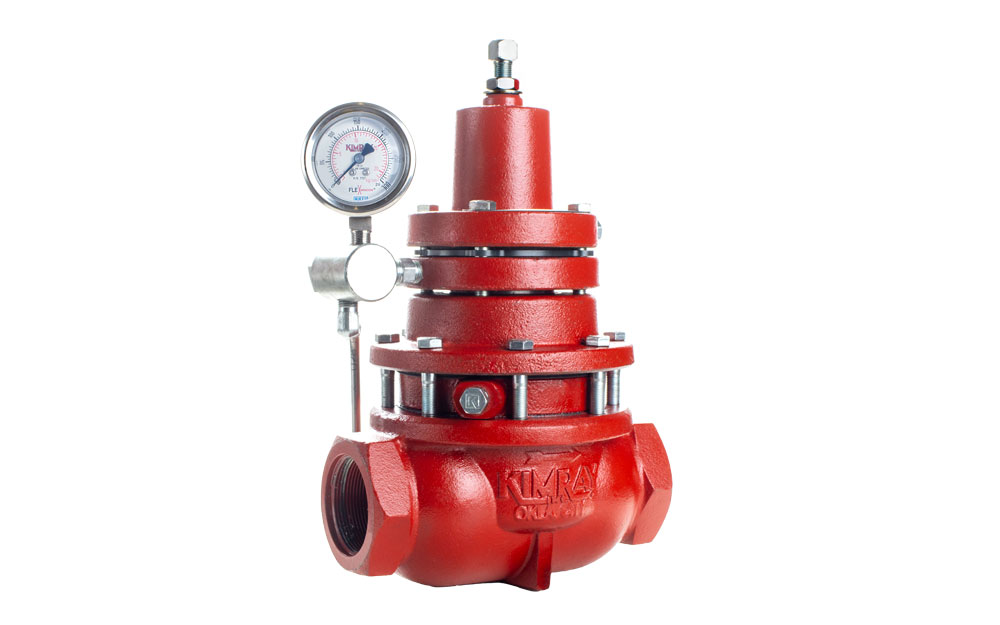One of the ways energy producers are creating emissions-free operation is by using compressed air as the source of outside supply for control devices.
The back pressure regulator with outside supply, or BPOS, and the pressure reducing regulator with outside supply, PROS, can be purchased new or converted from a standard regulator. For a step-by-step guide, check out our conversion videos.
How to Convert a Back Pressure Regulator to Outside Supply
How to Convert a Pressure Reducing Regulator to Outside Supply
In this video, we’ll help you better understand these valves by walking through an animation of what’s happening when using compressed air as a source of outside supply.
How Does a Back Pressure Regulator Work with an Outside Supply of Compressed Air?
Producers use a Back Pressure Regulator to monitor and control upstream pressure. Here's how the BPOS it works:
Upstream pressure enters the valve, travels under the seat and exits through the downstream side of the body.
Upstream pressure also travels through the sense line into the pilot housing and underneath the diaphragm of the pilot assembly.

With the adjusting screw unthreaded, there is very little tension on the pilot assembly, about 10 PSI.
In this position, the pilot plug is pushing against the upper seat, closing off the lower seat.
The outside source of supply pressure, commonly compressed air, travels through a filter where debris is caught before entering the upper housing and under the pilot plug. This flow is blocked by the closed lower seat.

The supply pressure to the regulator needs to be at least 60% of upstream pressure. For example, if you’re trying to hold 100 PSI, you need at least 60 PSI of supplied air. If you have the ability, just match the supply air pressure with your set point.
When the adjusting screw is tightened and the spring tension is greater than the upstream pressure, it forces the pilot assembly to move down.

This positions the pilot plug to open the lower seat and allows outside supply pressure to enter the upper housing cavity and push down on the diaphragm, moving the valve to a closed position.
The upstream flow pushes up on the valve seat as the supply pressure is pushing down on the diaphragm. Because the area of the diaphragm is twice the area of the seat, the regulator can be held in a closed position with equal pressure on both surfaces.

If upstream pressure exceeds the spring tension, which is your set point, it pushes the pilot assembly up, closing the lower seat and cutting off the supply pressure from entering the housing.
The outside supply pressure that had been holding the valve closed then vents through the breather plug on the bonnet allowing the valve to open and the upstream pressure to be regulated.

The regulator will control upstream pressure as it increases or decreases, maintaining a constant back pressure set point.
How Does a Pressure reducing Regulator Work with an Outside Supply of Compressed Air?
Producers use a Pressure Reducing Regulator to monitors and control downstream pressure.
Upstream pressure enters the valve, travels under the seat and exits through the downstream side of the body.
This downstream pressure also travels through the sense line into the pilot housing and underneath the diaphragm of the pilot assembly.

An outside source of supply pressure travels through a filter where debris is caught before entering the upper housing, beneath the lower seat. This pressure fills the upper housing cavity and pushes down on the diaphragm, closing the valve seat.

Because the motor valve diaphragm area is twice that of the seat, the regulator can be held in a closed position with equal pressure on both surfaces.
The pilot plug lower seat is closed, blocking upstream pressure.
The pilot plug upper seat, which is the pressure vent, is open, allowing diaphragm pressure to vent from underneath the motor valve diaphragm and the valve seat to be in the closed position.
With the adjusting screw unthreaded, there is very little tension on the pilot assembly, about 10 PSI.
When the adjusting screw is tightened and the pilot spring tension is greater than the downstream pressure, it forces the pilot assembly to move down.

This pushes down on the pilot plug and opens the lower seat, allowing supply pressure to flow into the cavity of the lower housing, below the diaphragm.
Now the pressures are equalized on both sides of the diaphragm and the upstream pressure can push open the valve seat.

The booster spring helps the regulator to open by pushing up on the diaphragm plate, raising the valve seat.
When downstream pressure exceeds the spring tension, which is your set point, it pushes against the pilot assembly, closing off the lower seat and the outside supply pressure from the lower housing.
The pressure that was in the lower housing is then vented through the breather plug in the bonnet.

With the downstream pressure at the set point, the pilot assembly assumes a position in which both seats of the pilot plug are closed.
Now the regulator will maintain and control a constant downstream pressure set point.
Want to explore more about Kimray's zero-emission solutions? Check out Kimray.com/emissions.




























